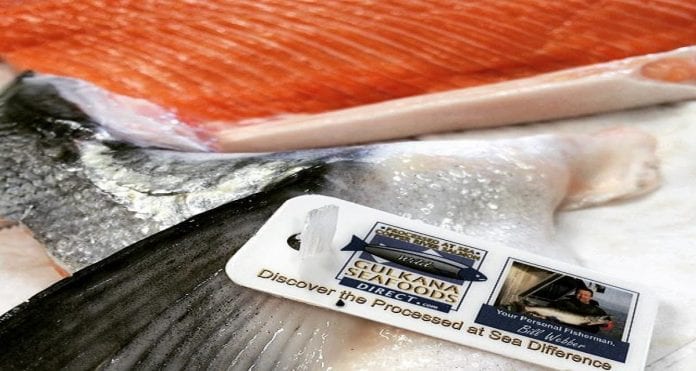
Veteran fisherman Bill Webber is out to change the fortunes of harvesters of wild caught salmon who want more value for their product with his paradigm for getting those fish from the ocean to markets everywhere.
A third-generation fisherman born and raised in Cordova, 2017, Webber is proud of the high quality of his salmon product, and eager to educate fellow harvesters and consumers alike how he does it.
After half a century in commercial fisheries, 2017 being Webber’s 50th year harvesting sockeye and coho salmon in the Copper River Delta fishery, he said he’s still enjoying his career at sea.

Starting with a 22-foot cabin skiff in the late 1960s, he says, he graduated into incrementally better boats, and along the way also has owned and operated Gulkana Seafoods Direct, plus Webber Marine and Manufacturing Inc.
Six years ago, after his old vessel swamped on the Copper River, Webber built a new 35-foot fishing boat, the F/V Paradigm Shift, one of the largest in the Copper River area fleet, complete with processing work stations and an integrated intravenous pressure bleeding system.
While the harvester-director business model Webber uses was developed over the past 17 years, he says he’s still always looking for ways to improve it.
Webber says the key to the quality of his fish, which he markets via www.gulkanaseafoods.com, is that he catches and processes the wild salmon pre-rigor mortis, employing that intravenous pressure bleeding system.
Also determined to educate consumers, he offers details on his website of how his salmon are processed, including why he prefers pressure bleeding over dry or live immersion processes.

Understanding the importance of bleeding salmon is paramount to wild salmon harvesters who want to produce a quality product, he said.
The intravenous pressure bleeding system, which he favors over dry bleeding or live immersion bleeding, is best done by the harvester in an onboard pre-rigor processing operation, he explains on his website’s blog section.
For the intrigued, if not the faint at heart, Webber explains and demonstrates himself in a 10-minute video of just how that process works aboard his fishing vessel. The video is online at
https://www.youtube.com/watch?v=NjYiqRzWoms&feature=youtube_gdata_poster
“This processing totally eliminates any and all enzymatic degradation,” Webber said. “The result greatly extends the shelf life of the product, and they see it when they open the box of fish. They can tell the fish is very clean too. We go through extensive cleaning of the belly cavity.”
His company fishes and ships wild Alaska salmon directly to “some of the nation’s finest restaurants and premiere chefs, as well as to source conscious buyers,” he said. He also supplies some families all over the United States with 100 to 100 pounds of salmon annually.
“Our fresh and frozen products have a longer shelf life,” he said. “The frozen is good up to a year or 18 months. The fresh product usually gets consumed right away, whether to a seafood wholesaler, restaurant or retail store.”
For shoppers looking for their own meals or gifts during the 2017 holiday season, Gulkana Seafoods is offering Copper River sockeye and coho salmon portions for sale on its website, shipped overnight to an Alaska Airline cargo terminal near the customer, or to the customers doorstep on the second day, via UPS or FedEx.
He encourages everyone to order early to assure greatest assurance of delivery, and instructs customers on how to track their shipment via Alaska Airlines. “For those who want fish shipped to their address via UPS or FedEx, a tracking number is printed on the bottom of your invoice, so you can follow your fish while in transit,” he said.
Gulkana Direct used to also do a smoked product, with the smoking process done by Copper River Seafoods in Cordova, but that ended when Copper River Seafoods closed its smoke shop three years ago, he said. Meanwhile another local entrepreneur purchased the smoking equipment and Webber said he is considering having that company do smoking for his company in the future.
The sockeye season, which runs from mid-May to the first week of August, yields his most popular product. Then come the silver salmon, from mid-August to about Sept. 25. If the demand were greater, he would keep fishing, but for the Steller sea lions, harbor seals and abundance of sea otters, who are pretty aggressive, he said.
Meanwhile Webber said he’ll be going through a rebranding effort this winter, with a goal of improving his business model, and maintaining stringent quality control and onboard processing techniques “that allow my harvest to be all it can be as Mother Nature intended.”














